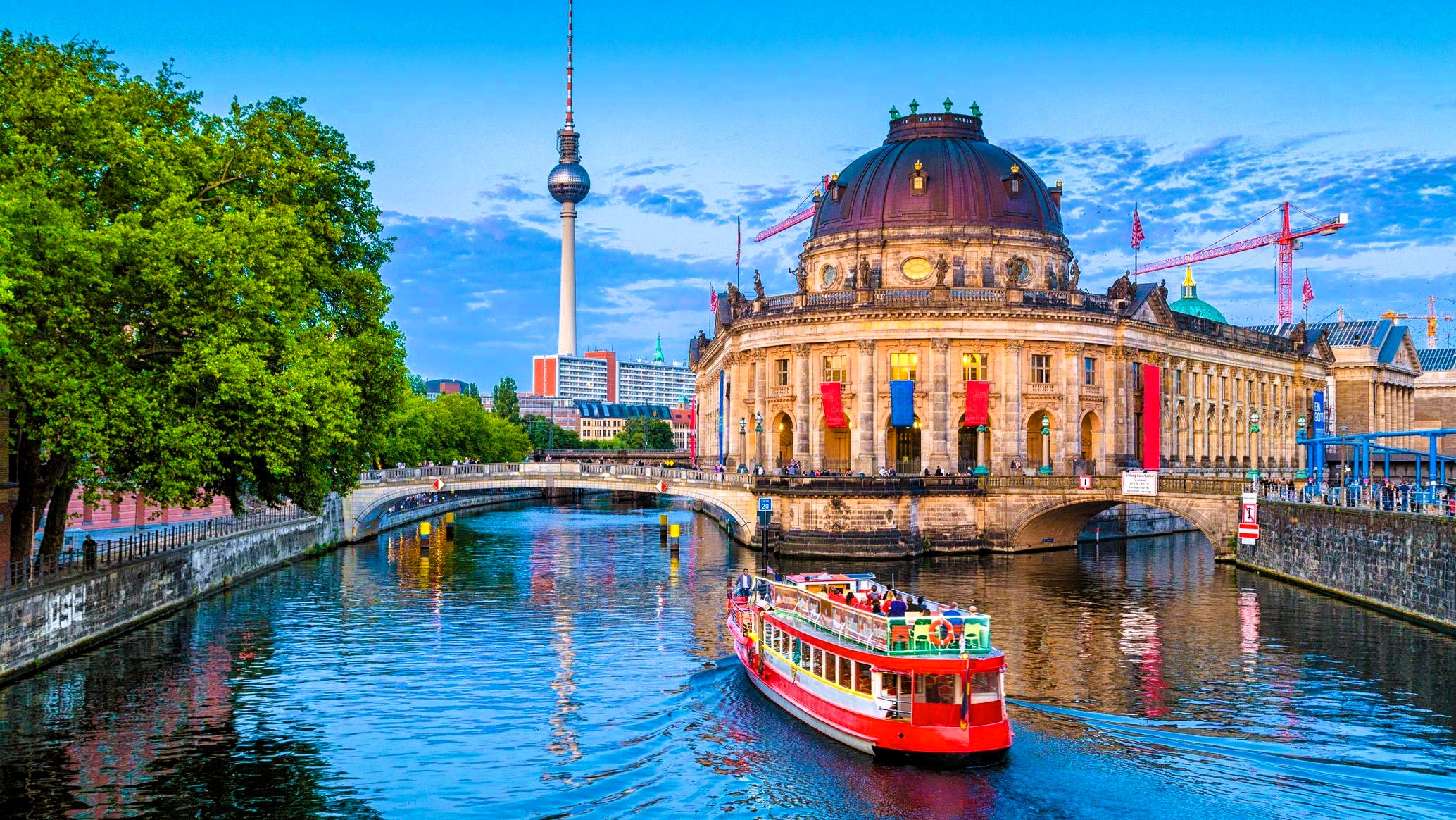독일의 활기 넘치는 수도 베를린은 역사, 문화, 그리고 현대적인 면모가 완벽하게 어우러진 도시입니다. 상징적인 브란덴부르크 문부터 크로이츠베르크의 번화한 거리까지, 베를린은 모든 여행객에게 특별한 경험을 선사합니다. 하지만 베를린의 날씨는 여행 경험에 큰 영향을 미칠 수 있습니다. 뚜렷한 계절과 다양한 기온을 자랑하는 이 역동적인 도시의 매력을 만끽하려면 적절한 시기를 선택하는 것이 매우 중요합니다. 이 종합적인 날씨 가이드에서는 베를린을 방문하기 가장 좋은 시기를 살펴보고, 기후, 계절별 볼거리, 그리고 완벽한 여행 계획을 위한 유용한 팁을 알려드립니다.
베를린의 기후 이해
베를린은 따뜻한 여름, 추운 겨울, 그리고 온화한 계절 변화를 특징으로 하는 온대 대륙성 기후를 지닙니다. 연중 적당한 강수량을 보이며, 뚜렷한 건기는 없습니다. 베를린의 날씨를 간략하게 살펴보겠습니다.
- 겨울(12월~2월): 춥고 눈이 자주 내리며, 기온은 영하 2도에서 4도(화씨 28도에서 39도) 사이입니다. 낮이 짧고 흐린 하늘이 흔합니다.
- 봄(3월~5월): 기온이 점차 따뜻해지면서 4°C에서 15°C(39°F에서 59°F) 사이로 예상됩니다. 강수량은 적당하며, 도시에는 푸른 나무들이 피어나기 시작합니다.
- 여름(6월~8월): 따뜻하고 때로는 더운 날씨이며, 평균 기온은 15°C에서 25°C(59°F에서 77°F)입니다. 이 시기는 관광 성수기로, 낮이 길고 가끔 폭염이 찾아옵니다.
- 가을(9월~11월): 6°C에서 18°C(43°F에서 64°F)까지 시원한 기온이 예상됩니다. 겨울이 다가오면서 상쾌한 공기, 화려한 단풍, 그리고 강수량 증가가 예상됩니다.
이제 날씨, 이벤트, 군중 수준을 기준으로 베를린을 방문하기 가장 좋은 달을 알아보겠습니다.
베를린을 방문하기 가장 좋은 달
1. 5월~6월: 초여름의 행복
왜 방문해야 할까요?
5월과 6월은 베를린의 따뜻한 날씨가 시작되는 시기로, 도보나 자전거로 도시를 둘러보기에 이상적입니다. 기온은 보통 10°C에서 20°C(50°F에서 68°F) 사이이며, 햇살이 풍부하고 공원에는 꽃이 만발합니다. 여름 성수기에 비해 베를린은 비교적 한산하여 박물관 섬이나 베를린 장벽과 같은 인기 명소를 긴 줄 없이 둘러볼 수 있습니다.
날씨 주요 내용:
- 평균 최고 기온: 15°C ~ 20°C (59°F ~ 68°F)
- 평균 최저 기온: 8°C ~ 11°C (46°F ~ 52°F)
- 강수량: 보통, 가끔 소나기가 내림
- 일광: 6월 말까지 최대 16시간으로 관광에 최적
할 일:
- 봄꽃과 푸른 나무로 가득한 베를린의 넓은 중앙 공원, 티어가르텐을 산책해 보세요.
- 참석하다 문화의 카니발 (문화 카니발)은 5월에 열리는 베를린의 다문화주의를 기념하는 활기찬 거리 축제입니다.
- 마우어파크와 같은 야외 시장을 탐험해 보세요. 그곳에서는 현지 음식과 라이브 음악을 즐길 수 있습니다.
팁: 갑작스러운 소나기에 대비해 가벼운 재킷과 우산을 챙기세요. 베를린의 자갈길과 광활한 관광 명소를 걷다 보면 걷기가 힘들 수 있으니 편안한 운동화는 필수입니다.
2. 9월~10월 초: 가을의 매력
왜 방문해야 할까요?
서늘한 날씨와 한적한 분위기를 선호하신다면 9월과 10월 초가 베를린을 방문하기에 더할 나위 없이 좋은 시기입니다. 여름 더위가 누그러지면서 기온이 10°C에서 18°C(50°F에서 64°F)로 오르고, 도시의 공원들은 황금빛과 붉은빛 단풍으로 물듭니다. 또한, 문화 행사와 축제를 즐기기에도 좋은 시기입니다.
날씨 주요 내용:
- 평균 최고 기온: 14°C ~ 19°C (57°F ~ 66°F)
- 평균 최저 기온: 9°C ~ 11°C (48°F ~ 52°F)
- 강수량: 보통, 가끔 비가 오는 날도 있음
- 일광: 점점 줄어들고 있지만 낮 시간 탐험에는 여전히 충분합니다(9월 기준 약 12~14시간)
할 일:
- 방문하세요 베를린 마라톤 9월 말, 세계에서 가장 유명한 달리기 행사 중 하나가 열립니다. 참가자들을 응원하기 위해서라도요.
- 한적한 시간에 체크포인트 찰리와 홀로코스트 기념관 등 도시의 역사적 명소를 둘러보세요.
- 즐기세요 베를린 아트 위크 9월에는 다양한 갤러리와 장소에서 현대 미술을 선보입니다.
팁: 아침 저녁으로는 쌀쌀할 수 있으니 겹쳐 입을 수 있는 옷을 준비하세요. 비 오는 날에는 방수 재킷이나 우산이 편리합니다. 베를린 마라톤과 같은 주요 행사 기간에 방문하시는 경우, 숙박은 미리 예약하세요.
3. 7월~8월: 여름의 정취가 최고조에 달하는 시기
왜 방문해야 할까요?
따뜻한 날씨와 활기찬 분위기를 좋아하는 분들에게 베를린을 방문하기 가장 좋은 시기는 7월과 8월입니다. 이 시기는 관광 성수기로, 기온이 20°C에서 25°C(68°F에서 77°F)까지 오르는 경우가 많고, 때로는 그보다 더 높을 때도 있습니다. 낮이 길어(최대 16.5시간) 일정에 더 많은 액티비티를 추가할 수 있습니다.
날씨 주요 내용:
- 평균 최고 기온: 22°C ~ 25°C (72°F ~ 77°F)
- 평균 최저 기온: 14°C ~ 16°C (57°F ~ 61°F)
- 강수량: 보통, 가끔 뇌우가 내림
- 일광: 낮이 길어 야외 활동에 이상적
할 일:
- 반제(Wannsee)나 뮈겔제(Müggelsee) 등 베를린의 수많은 호수 중 한 곳에서 수영이나 피크닉을 즐기며 휴식을 취해보세요.
- 야외 콘서트 및 이벤트에 참석하세요. 베를리너 돔 야외 콘서트 또는 야외 영화관에서 영화를 상영합니다.
- 맥주 가든과 옥상 바가 한창인 베를린의 활기찬 밤 문화를 탐험해 보세요.
팁: 성수기에는 가격이 급등하므로 항공편과 숙박은 미리 예약하세요. 자외선 차단제, 모자, 가벼운 옷을 챙기고, 서늘한 저녁이나 갑작스러운 비에 대비하여 재킷도 준비해 두세요. 붐비는 명소와 긴 대기 시간에 대비하세요.
고려해야 할 다른 달
4월: 예산에 맞는 봄철 옵션
4월은 어깨 달로, 온화한 날씨(섭씨 7도에서 13도 사이, 화씨 45도에서 55도 사이)와 적은 관광객으로 북적입니다. 비가 올 수도 있지만, 도시는 봄꽃으로 깨어나고, 부활절 축제에는 종종 독특한 시장과 행사가 열립니다. 성수기보다 항공권과 호텔 가격이 저렴하여 저예산 여행객에게 좋은 시기입니다.
할 일: 방문하세요 브리처 가르텐봄에는 튤립 전시가 펼쳐지는 아름다운 공원을 방문하거나, 조용한 날에는 베를린의 여러 박물관을 둘러보세요.
팁: 예측 불가능한 날씨에 대비해 옷을 여러 겹 겹쳐 입으세요. 비옷, 튼튼한 신발이 필수입니다.
10월 말부터 11월: 비수기 조용함
서늘한 기온(섭씨 4도에서 9도, 화씨 39도에서 48도)을 괜찮게 느끼고, 인파를 완전히 피하고 싶다면 늦가을이 평화로운 여행이 될 수 있습니다. 숙박비도 더 저렴합니다. 하지만 해가 짧아지고 날씨가 습하고 음울할 수 있습니다.
할 일: 페르가몬 박물관 같은 실내 명소를 둘러보거나, 전통 독일 펍에서 푸짐한 식사를 즐기며 아늑한 시간을 보내세요. 11월 말부터 베를린의 유명한 크리스마스 마켓이 시작됩니다.
팁: 스카프, 장갑, 방수 코트 등 따뜻한 옷을 입으세요.
베를린에서 피해야 할 달
12월~2월: 혹독한 겨울
베를린의 겨울은 관광객들에게, 특히 추운 날씨에 익숙하지 않은 사람들에게는 힘든 시간이 될 수 있습니다. 기온이 영하를 오르내리는 경우가 많고, 눈이 오면 여행 계획이 차질을 빚을 수 있습니다. 12월의 크리스마스 마켓이 큰 인기를 끌지만, 짧은 낮(낮 시간이 8시간밖에 되지 않음)과 빙판길 때문에 야외 활동은 다소 불편할 수 있습니다.
예외: 휴가철에 방문한다면 12월은 축제 분위기가 물씬 나는 시기로, 젠다르멘마르크트와 샤를로텐부르크 궁전의 시장이 열리는 시기이므로 고려해 볼 만합니다.
3월: 예측 불가능한 날씨
3월은 예측할 수 없는 날씨로 가득한 변화의 달입니다. 차가운 바람과 간간이 내리는 눈 때문에 겨울 같은 느낌이 들 수도 있지만, 봄의 기운을 느낄 수도 있습니다. 계획에 여유가 없다면, 더 안정적인 날씨를 위해 4월이나 5월까지 기다리는 것이 좋습니다.
베를린 방문을 위한 일반 팁
- 예보를 확인하세요: 베를린의 날씨는 급변할 수 있으므로 여행 며칠 전부터 현지 일기예보를 꼼꼼히 확인하세요. Weather Underground나 Deutscher Wetterdienst(DWD) 같은 앱은 믿을 만합니다.
- 다음 사항에 따라 포장하세요: 계절에 관계없이 기온 변화에 대비하여 겹쳐 입을 수 있는 옷을 챙기세요. 베를린은 자갈길이 많아 걷기 좋은 도시이므로 편안한 운동화는 필수입니다.
- 이벤트를 중심으로 계획하세요: 베를린에서는 일 년 내내 다양한 축제와 행사가 열립니다. 베를린 공식 관광 웹사이트(visitberlin.de)에서 최신 행사 일정을 확인하여 특별한 추억을 만들어 보세요.
- 대중교통: 베를린의 효율적인 대중교통 시스템(지하철, 에스반, 트램, 버스)은 날씨에 관계없이 운행되므로 비오는 날이나 눈이 오는 날에도 쉽게 이동할 수 있습니다.
- 비수기 할인: 성수기(4~5월 또는 9~10월)에 방문하면 항공편, 호텔, 투어 비용을 절약할 수 있으며 날씨도 쾌적합니다.
결론: 베를린을 언제 방문해야 할까요?
베를린을 방문하기 가장 좋은 시기는 날씨, 인파, 그리고 액티비티에 따라 달라집니다. 날씨가 온화하고 관광객이 적은 경우, 5월부터 6월까지 그리고 9월~10월 초 이상적입니다. 따뜻한 날씨와 활기찬 분위기를 원하신다면, 7월부터 8월까지 완벽하지만, 비용이 더 많이 들고 인파도 많을 수 있다는 점을 염두에 두고 계획해야 합니다. 저예산 여행객이나 축제 분위기를 즐기는 분들은 4월 또는 11월 말부터 12월까지 크리스마스 마켓을 위해서.
언제 방문하시든, 베를린의 풍부한 역사, 다채로운 문화, 그리고 다채로운 볼거리는 잊지 못할 추억을 선사합니다. 이 날씨 가이드를 참고하여 여행을 계획하고, 짐을 알차게 챙기고, 독일의 매혹적인 수도에서 최고의 시간을 보내세요. 베를린 방문 시기를 정하셨나요? 댓글로 알려주세요. 즐거운 여행 되세요!


